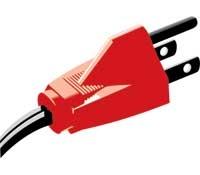Power Play

About six years ago, electronics-industry honchos started holding big powwows to discuss the feasibility of giving household power lines (the electrical wiring you plug all your stuff into) the ability to also carry communications signals - as in music, computer data, Internet access, episodes of Buffy the Vampire Slayer.
... The Shangri-la app would be a technology that lets you, say, play a CD in the living room and have the music also come out of speakers by the pool, with the only wires in between being the ones already running behind your walls. Just plug everything into the outlets, and the Electric Light Orchestra would somehow find its way. Same would go for a house with just one cable-TV connection. Any set plugged into a standard outlet would be able to receive that signal (a dream come true for bedroom-bound, Skinemax-loving high-school guys everywhere).
Oleg Logvinov, president and CEO of comm-tech company Arkados, recalls an early industry gathering where one highly charged audience member listening to the presentation stood up and said, "Can you imagine what we're trying to accomplish here? We're going to ask consumers to plug all their devices into power outlets." At that, he looked around, turned red, and sheepishly sat back down.
You can forgive the guy for forgetting that we already plug everything into power outlets. The concept seemed too easy, too perfect - something had to be wrong with it. And yet some of the finest engineering minds are now ready to flick the switch on a revolutionary new digital technology that will let you pump high-def video throughout your house - all without a custom-installation job. Will it really work?
PLUG AND PLAY
Well, it already is working. Since late 2004, RadioShack has been selling HomePlug products from Accurian, including a set of powered speakers with built-in volume, treble, and bass controls ($180). There's also an audio transmitter ($100) to which you connect sources like your receiver or CD player. You then plug the transmitter into an outlet to stream the music to the Accurian speakers, which are plugged into an outlet on the other end. If you're using traditional speakers, there's a 50-watt digital amp ($150) you can hook up to them using good ol' speaker wire. Other stores offer power-line Ethernet bridges and USB adapters for home networking.
Several of us S&Vers have actually seen power-line tech in action in our very own headquarters, thanks to a demo from Logvinov and Arkados's marketing director Jim Reeber, who connected a music-streaming laptop to a HomePlug adapter plugged into a regular outlet. Plugged into another outlet were powered speakers with digital signal processing. The PC fed jazz into the office's power lines and out to the speakers. When Reeber wanted to change the music, he aimed his remote not at the computer but the speakers, which sent the command to the PC via the power lines. And then there was the blues.




























































